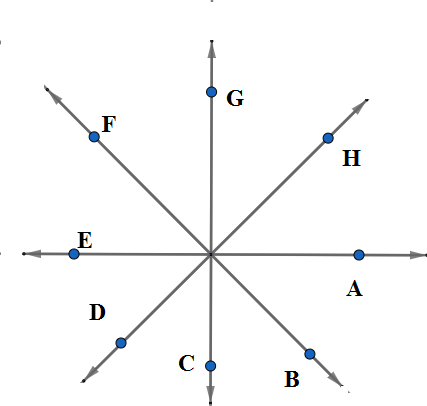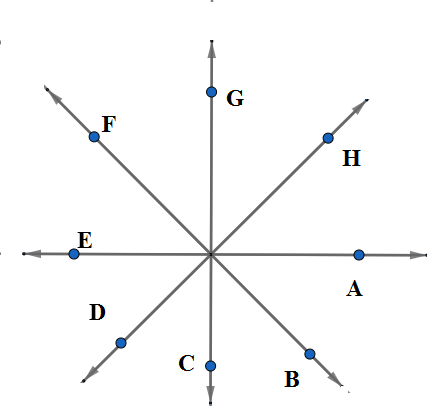
How many rays are represented in figure? Name them.


Answer
476.1k+ views
Hint: We see in the figure that there are 4 straight lines. We take one point in each line as the initial point and the one other point which is towards the arrow tip to get 2 rays in each straight line. We find how many rays there are in 4 lines.
Complete step by step answer:
We know that each ray has an initial point where the ray begins and we name the ray with another point on the ray excluding the initial point. If


We observe the given figure from the right hand side point A and keep looking in clockwise direction. We see that we have 4 straight lines which are
Let us observe the straight line
Let us observe the straight line
Let us observe the straight line
Let us observe the straight line
So the names of all the rays from the figure are
So there are 8 rays.
Note:
We know that a straight line is a basic geometric figure is made up of points and extending in two directions. A ray is part of the straight line but extended in only one direction. When two rays have a common point then they form an angle. We see in the figure that all the rays pass through the common point and hence at the common point many angles are formed.
Complete step by step answer:
We know that each ray has an initial point where the ray begins and we name the ray with another point on the ray excluding the initial point. If


We observe the given figure from the right hand side point A and keep looking in clockwise direction. We see that we have 4 straight lines which are
Let us observe the straight line
Let us observe the straight line
Let us observe the straight line
Let us observe the straight line
So the names of all the rays from the figure are
So there are 8 rays.
Note:
We know that a straight line is a basic geometric figure is made up of points and extending in two directions. A ray is part of the straight line but extended in only one direction. When two rays have a common point then they form an angle. We see in the figure that all the rays pass through the common point and hence at the common point many angles are formed.
Latest Vedantu courses for you
Grade 11 Science PCM | CBSE | SCHOOL | English
CBSE (2025-26)
School Full course for CBSE students
₹41,848 per year
Recently Updated Pages
Express the following as a fraction and simplify a class 7 maths CBSE

The length and width of a rectangle are in ratio of class 7 maths CBSE

The ratio of the income to the expenditure of a family class 7 maths CBSE

How do you write 025 million in scientific notatio class 7 maths CBSE

How do you convert 295 meters per second to kilometers class 7 maths CBSE

Write the following in Roman numerals 25819 class 7 maths CBSE

Trending doubts
Where did Netaji set up the INA headquarters A Yangon class 10 social studies CBSE

A boat goes 24 km upstream and 28 km downstream in class 10 maths CBSE

Why is there a time difference of about 5 hours between class 10 social science CBSE

The British separated Burma Myanmar from India in 1935 class 10 social science CBSE

The Equation xxx + 2 is Satisfied when x is Equal to Class 10 Maths

What are the public facilities provided by the government? Also explain each facility




